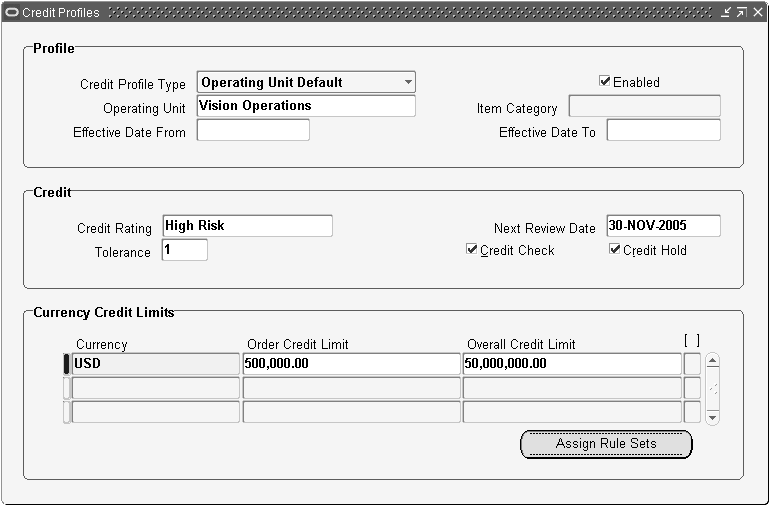This is a required step if you plan to use order credit checking. This step is divided into three steps:
Defining Credit Profiles
- Defining Credit Profiles
- Defining Credit Usage Rules
- Defining Credit Check Rules
Defining Credit Profiles
Organization Credit Profiles are a set of criteria that define an operating unit's credit policy for credit control and order credit checking. Credit Profiles include the credit limit and pertinent data needed to determine total credit exposure for orders undergoing credit checking.
Credit Profile Types
- Customer: Enables you to define credit limits by currency for Customers. Credit Profiles for Customer are defined when entering credit information in the Credit section of the Profile-Transactions tab of the Customer.
- Customer Site: Enables you to define credit limits by currency for Customer Sites. Credit Profiles for Customer Sites are defined when entering credit information in the Credit section of the Profile-Transactions tab of the customer site
- Operating Unit Default: Enables you to set credit limits and terms, by currency, within a given operating unit. It enable you to effectively enforce a formal credit checking process for all order transactions/currencies from any customer. For example, if a transaction is entered and no credit limits exist at the customer or customer site levels for the specified order currency, the Operating Unit Default Credit Profile for the transaction/currency entered will be used to determine credit availability.
Note: The Operating Unit Credit Profile is used as the default profile for all customers that do not have an individual credit profile either at customer or site level.
- Item Category: Enables you to set order credit limits, by currency, for one or more Item Categories. This type of profiles enables you to specify limits for the maximum amount on each order for an item category irrespective of a customer or site.
Item Category Credit Profiles are applicable across operating units. Item Category profiles are global credit profiles and are transaction currency based: the credit limits defined for an item category are for individual transactions (orders) only. There is no overall system credit limit for a category.
Note: Only categories associated with the default category set for the Order Management functional area are supported.
Credit Profile Limits Hierarchy when performing credit checking:
- Customer Site Profile
- Customer Credit Profile
- Operating Unit Default Credit Profile
Unlike the Operating Unit Default Credit Profile that defines credit limits for specific operating units,
Item Categories enable you to set order credit limits/profiles for one or more item category (applicable for all customers). For example, an Item Category Credit Profile can specify that the maximum order value cannot exceed $10,000 USD for any order lines that contain an item associated with the Item Category Computers. This is extremely useful if your business practice requires item-based insurance coverage.

Define New Credit Profile
- Navigate to the Define Credit Profiles window:
Order Management: Setup --> Credit --> Define Credit Profiles

- Valid Values for Credit Profile Type are: Item Category, Operating Unit Default
- Based upon the Credit Profile Type you chose, certain fields become protected or non-updatable.
Note: If Credit Profile Type = Operating Unit Default, the Item Category field is disabled.
If Credit Profile Type = Item Category, the Overall Credit Limit field is disabled.
- Enter remaining fields that require a value, or update any fields that contain a default value based upon the Credit Profile Type selected.
- Operating Unit: Select an Operating Unit name from a list of values if you are defining a Operating Unit Default Credit Profile.
- Item Category: Select an Item Category name from a list of values if you are defining an Item Category Credit Profile.
- Effective Date From/ Effective Date To: Select the Effective Date From and Effective Date To for your Credit Profile.
Note: When defining Credit Profiles for Operating Unit Default and Item Category, the Effective Dates From/To cannot overlap previously defined Credit Profiles for the same Operating Unit Default or Item Category, regardless of the currency.
- Tolerance: Enter a numeric value in the Tolerance field. Tolerance values are used to calculate extended exposure limits during credit checking.
- For example, supposed you enter a value of 5 for Tolerance, and an Credit Limit of $10,000 USD. During credit checking, the exposure credit limit would actually be $10,500 USD. ((Tolerance + 100)* Credit Limit / 100).
- Currency: Select a value in the Currency field to limit the Credit Profile to a specific currency.
- Order Credit Limit: Enter a value in the Order Credit Limit field, based upon the Credit Profile Type. New orders may not exceed the value entered in the Order Credit Limit field if the checking processing defaults to the operating unit level.
- Overall Credit Limit: Enter a value in the Overall Credit Limit field for a Operating Unit Default Credit Profile Type. Total exposure within an operating unit for the particular customer may not exceed the value entered in the Overall Credit Limit field if credit checking processing defaults to the operating unit level.
- The following fields are for future use and are for information purposes only. Values that are ignored during the credit checking process are:
- Credit Check
- Credit Hold
- Credit Rating
- Next Review Date
- If you wish to enable multi currency credit check, you must assign Credit Usage Rule Sets to your Credit Profile. Select the Assign Rule Set button. The Assign Rule Set button is only enabled for the following Credit Profile Types:
- Item Category
- Operating Unit Default
- To assign Credit Usage Rules to Customer or Customer Sites Credit Profile Types, you must use the Assign Credit Usage Rules window.
- Save your work.
No comments:
Post a Comment